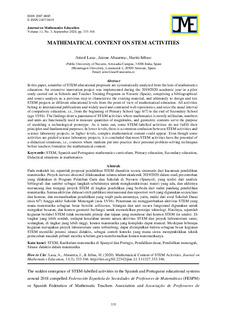Izenburua
Mathematical content on STEM activitiesEgilea
Beste instituzio
Universidad Pública de Navarra = Nafarroako Unibertsitate Publikoa (UPNA)Bertsioa
Bertsio argitaratua
Eskubideak
© The authorsSarbidea
Sarbide irekiaArgitaratzailearen bertsioa
https://doi.org/10.22342/jme.11.3.11327.333-346Non argitaratua
Journal on Mathematics Education Vol. 11, nº 3, pp. 333-346Lehenengo orria
333Azken orria
346Argitaratzailea
Universitas SriwijayaGako-hitzak
STEM
Spanish and Portuguese mathematics curriculum
Primary education
Secondary education ... [+]
Spanish and Portuguese mathematics curriculum
Primary education
Secondary education ... [+]
STEM
Spanish and Portuguese mathematics curriculum
Primary education
Secondary education
Didactical situations in mathematics [-]
Spanish and Portuguese mathematics curriculum
Primary education
Secondary education
Didactical situations in mathematics [-]
Laburpena
In this paper, a number of STEM educational proposals are systematically analyzed from the lens of mathematics education. An extensive innovation project was implemented during the 2019/2020 academic ... [+]
In this paper, a number of STEM educational proposals are systematically analyzed from the lens of mathematics education. An extensive innovation project was implemented during the 2019/2020 academic year in a pilot study carried out in Schools and Teacher Training Programs in Navarre (Spain), comprising a bibliographical and source analysis as a previous step to characterize the existing material, and ultimately to design and test STEM projects at different educational levels from the point of view of mathematical education. All activities belong to international publications and widely used and contrasted web repositories, and seize the usual interval of compulsory education, i.e., from the beginning of Primary School (age 6/7) to the end of Secondary School (age 15/16). The findings draw a panorama of STEM activities where mathematics is mostly utilitarian, numbers and units are functionally used to measure quantities of magnitudes, and geometric contents serve the purpose of modeling a technological prototype. As it turns out, some STEM-labelled activities do not fulfill their principles and fundamental purposes. In lower levels, there is a common confusion between STEM activities and science laboratory projects; in higher levels, complex mathematical content could appear. Even though some activities are guided science laboratory projects, it is concluded that most STEM activities have the potential of a-didactical situations, i.e., contexts where students put into practice their personal problem-solving techniques before teachers formalize the mathematical content. [-]
Sponsorship
Gobierno de NavarraProjectu ID
Integration of the maths curriculum for STEM proposals: design, implementation and evaluationBildumak
- Artikuluak - Hezkuntza [102]
Item honek honako baimen-fitxategi hauek dauzka asoziatuta:























